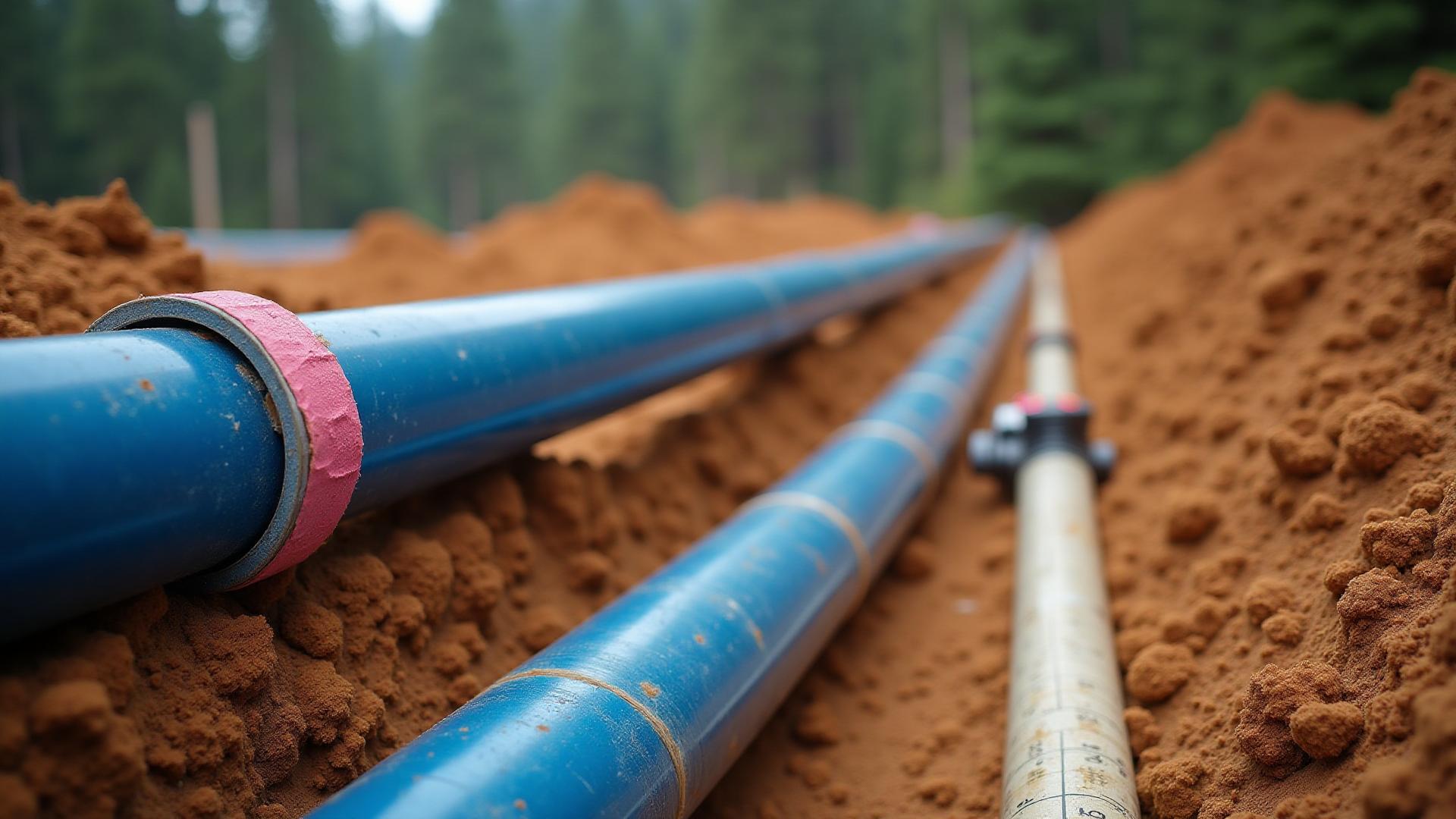
Water Line Installation
Water line installation delivers reliable domestic water from wells, municipal meters, or springs to your home, shop, or barn—running deep enough to survive mountain winters and protected against freeze damage. Tacoma Creek Build Co. installs water service lines across Spokane County, Pend Oreille County, Kootenai County, and Bonner County using HDPE pipe, tracer wire, insulation where needed, and trenching depths that exceed local frost lines. Whether you're connecting a new build in Sandpoint to a municipal main, running a line from a well in Newport, or replacing aging galvanized pipe near Coeur d'Alene, we deliver code-compliant installations that pass inspection and provide decades of trouble-free service.
Inland Northwest properties face unique water line challenges: frost lines run 36–48 inches deep, rocky ground requires hydraulic breakers, and steep terrain demands careful pressure management. We've installed water lines across Bonner County lake properties, Pend Oreille timber lots, Kootenai hillsides, and Spokane suburban tracts—always with proper depth, bedding, and coordination with licensed plumbers or well drillers. When you need comprehensive site utilities, we coordinate land clearing, trenching, water lines, septic, and power as a turnkey package.
How We Complete Water Line Installation Projects
Route Planning & 811 Locate
Plan path and mark existing utilities
Trenching
Dig to 42+ inches below frost line
Bedding, Pipe & Tracer Wire
Lay pipe on sand bedding with copper tracer wire
Pressure Test
Pressurize line to verify no leaks before backfilling
Backfill, Compaction & Restoration
Restore grade with proper compaction
Ready to Get Started?
Contact us today for a free consultation and site evaluation. We'll provide a detailed quote and timeline for your project.
Equipment & Capabilities
Mini excavators
Trenchers
Hydraulic breakers
Pressure test pumps
Pipe fusion equipment
Compactors
All equipment is regularly maintained and operated by certified professionals with mountain terrain expertise.
Service Benefits
- Freeze Protection: Lines installed 42–48 inches deep (below frost) prevent winter freeze-ups and costly repairs.
- Long-Term Durability: HDPE pipe resists corrosion, freeze damage, and root intrusion—outlasting copper, galvanized, or PVC in most applications.
- Code Compliance: Proper depth, bedding, tracer wire, and pressure testing ensure inspections pass and insurance requirements are met.
- Site Coordination: We work with licensed well drillers, plumbers, and pump installers to ensure seamless connections and startup.
- Cost Control: Efficient trenching minimizes excavation time, reduces haul-off, and keeps projects on schedule and budget.
Our Process
Step 1: Route Planning & 811 Locate – We walk the site to plan the shortest, most practical route from water source (well, meter, spring) to the structure, avoiding obstacles like septic drainfields, large trees, rock outcrops, and existing utilities. 811 locates are requested to mark underground power, gas, and communication lines. We confirm trench depth requirements with local code (typically 42–48 inches below finished grade in the Inland Northwest).
Step 2: Trenching – Mini excavators or backhoes dig trenches to specified depth and width. Spoils are placed away from the trench edge to prevent cave-ins. Rock is broken with hydraulic hammers if encountered. Trench bottom is graded smooth (no protruding rocks) to prevent point loads on the pipe. If the run is long or passes under driveways, we may install pull strings for future utility additions.
Step 3: Bedding, Pipe & Tracer Wire – A 4–6 inch sand or pea gravel bedding is placed at trench bottom. HDPE water line (typically 1"–2" diameter for residential) is laid in the trench with smooth curves (no kinks). Copper tracer wire is taped to the pipe every 10–20 feet and connected to an above-ground access point for future locating. Insulation wrap or heat tape is added in extra-cold zones or shallow sections (under driveways).
Step 4: Pressure Test – Before backfilling, the line is pressurized to 100–150 psi (or per code) and held for 2–4 hours to verify no leaks at fittings, joints, or pipe. Any drops in pressure are investigated and repaired. This step prevents discovering leaks after trenches are backfilled—saving time, money, and frustration.
Step 5: Backfill, Compaction & Restoration – Once pressure-tested and approved, we backfill in 8–12 inch lifts, compacting each layer with a jumping jack or plate compactor. Caution tape is placed 12 inches above the pipe as a future locating aid. Final grade is restored to match surrounding terrain, and excess spoils are hauled off or spread per site plan. Tracer wire termination is flagged or marked at the structure.
Specs & Capabilities
- Equipment: Mini excavators (35C–60G), backhoes, trenchers, hydraulic breakers for rock, pressure test pumps, pipe fusion equipment (for HDPE connections), and compactors.
- Pipe Materials: HDPE (high-density polyethylene)—preferred for freeze resistance, flexibility, and longevity. Copper or PEX in conduit for special applications (short runs, above-grade sections). Galvanized steel avoided due to corrosion issues.
- Trench Depths: Minimum 42 inches in most of Inland Northwest (36-inch frost line + 6-inch buffer). Deeper if site is exposed, high elevation, or historically cold. Under driveways or roads: minimum 48 inches or per engineer.
- Tracer Wire: 12-gauge copper wire taped to pipe for future locating with electronic detectors. Accessible at both ends (well house, structure) with protected termination points.
- Site Conditions: We install through clay, sandy loam, gravel, decomposed granite, and moderate rock. Steep slopes handled with proper trenching angles and thrust blocks at bends. Long runs (>500 ft) may require booster pumps or larger diameter pipe—coordinated with your plumber or engineer.
- Freeze Protection: Insulation wrap (closed-cell foam) used under driveways or shallow sections. Heat tape (electric) available for problem areas prone to freezing (additional cost for wiring and power). Proper depth is the best freeze protection.
Frequently Asked Questions
Related Services & Resources
Let's Build Something Great Together
From initial site walk to final inspection, Tacoma Creek Build Co. delivers professional dirt work you can build on.